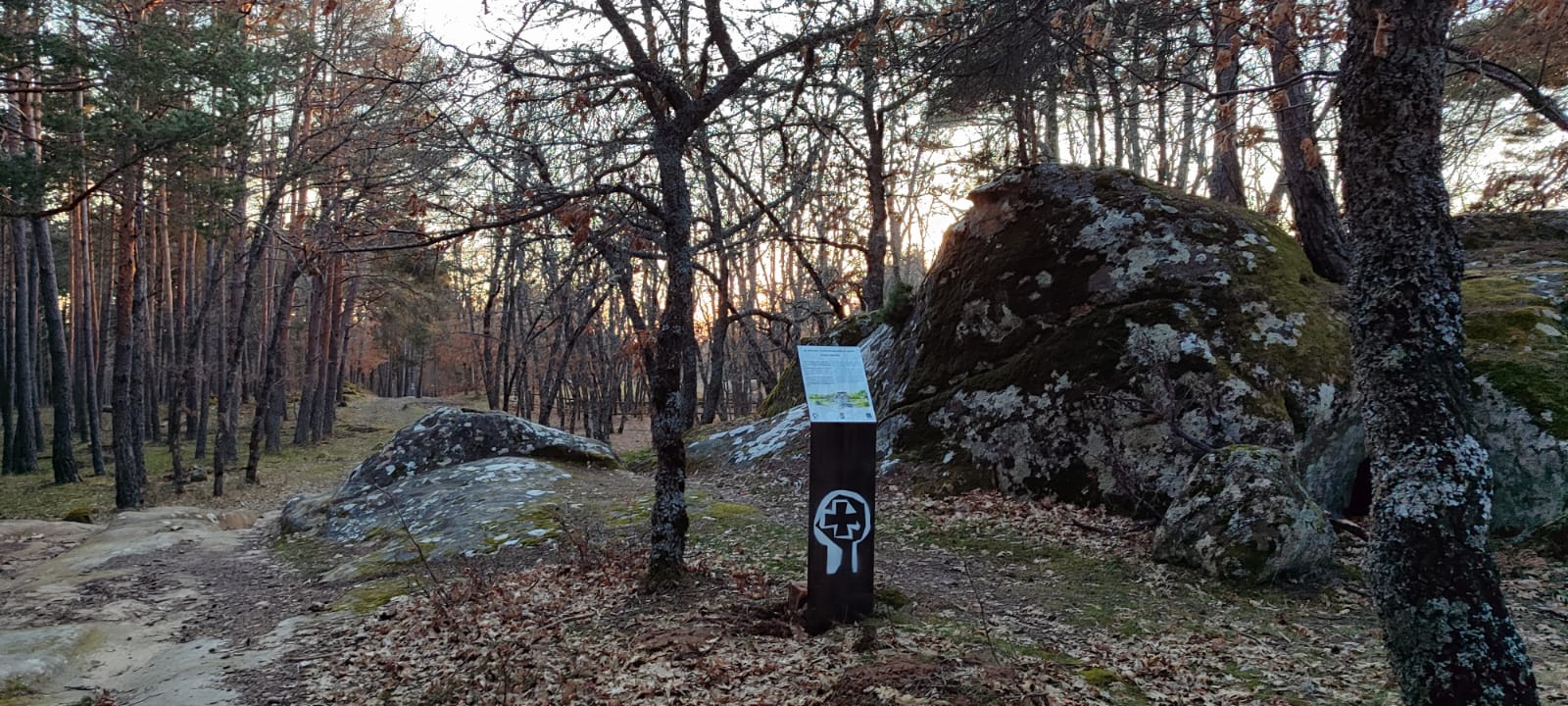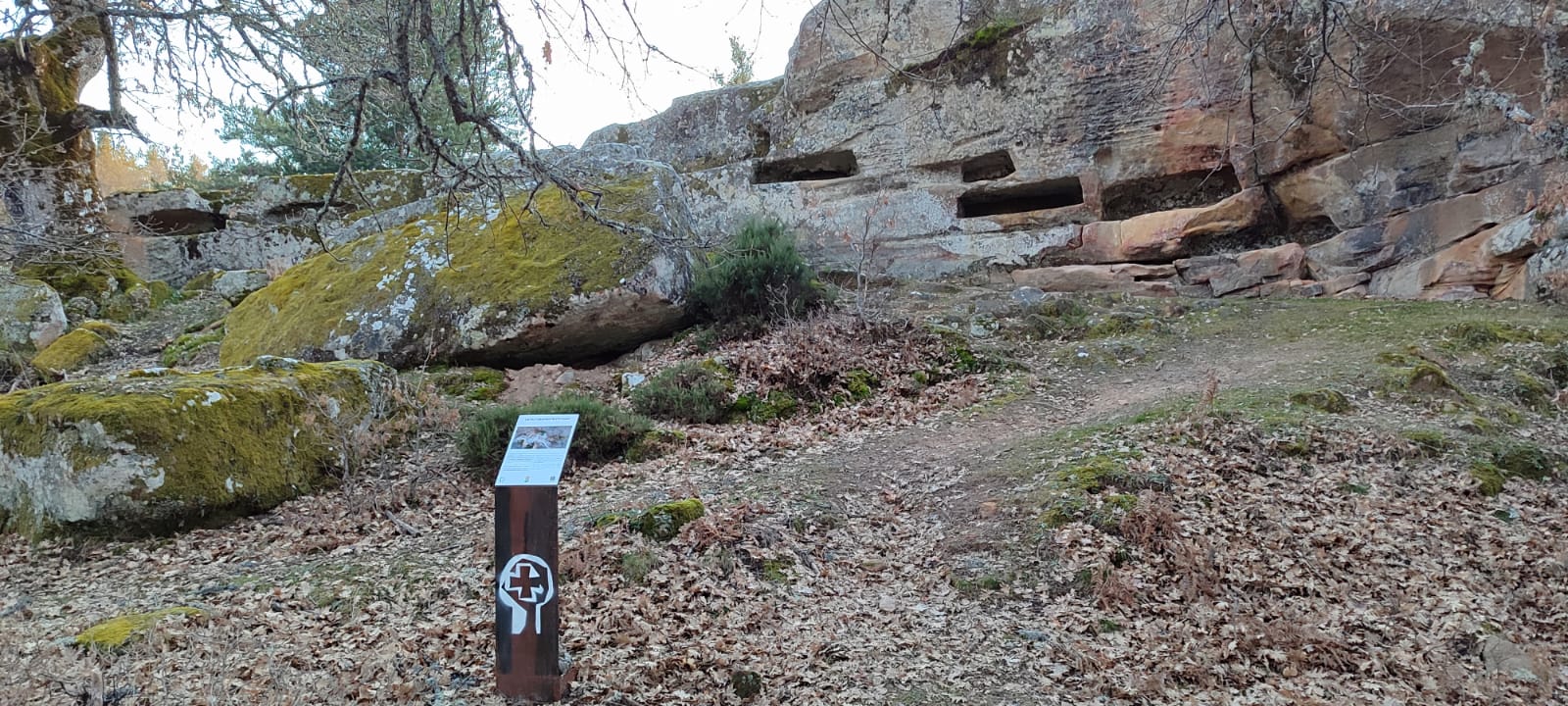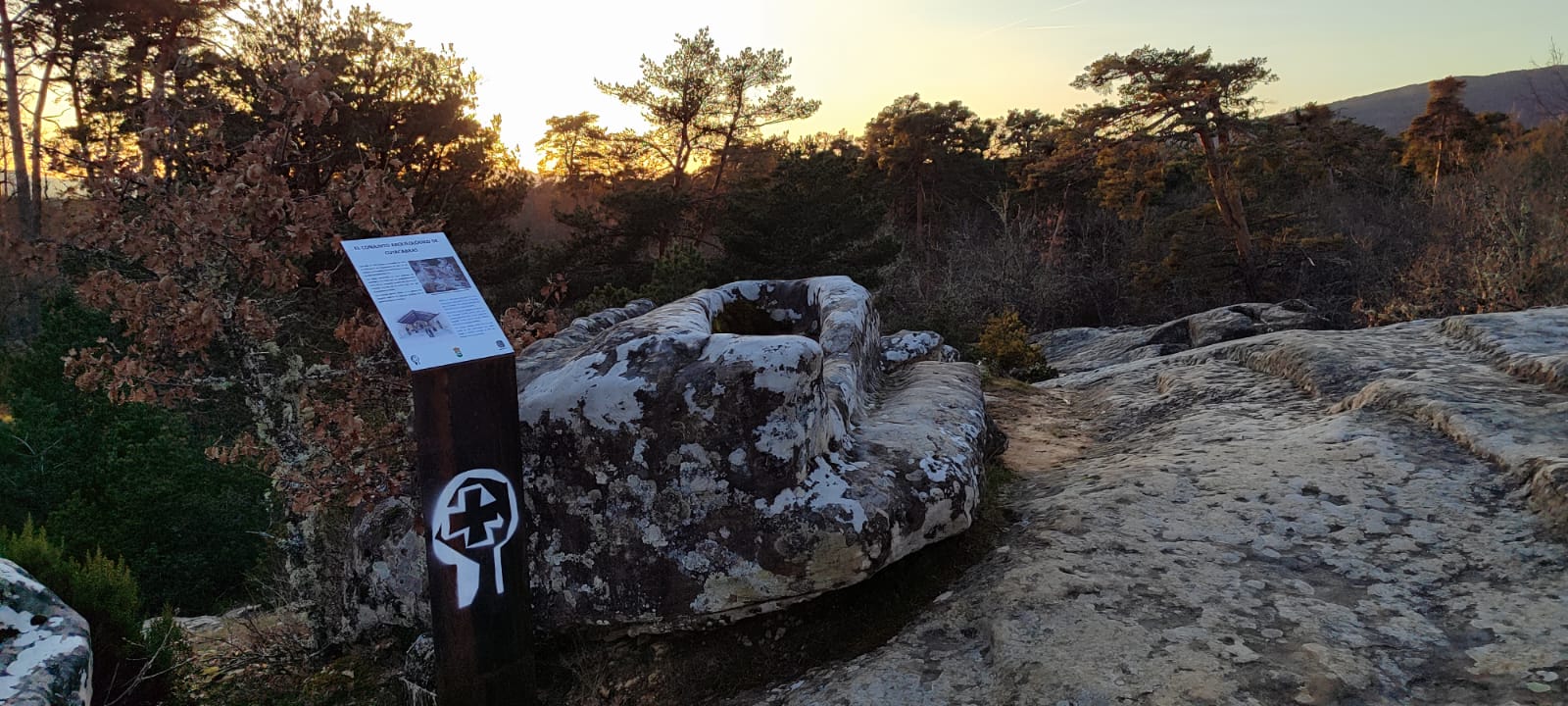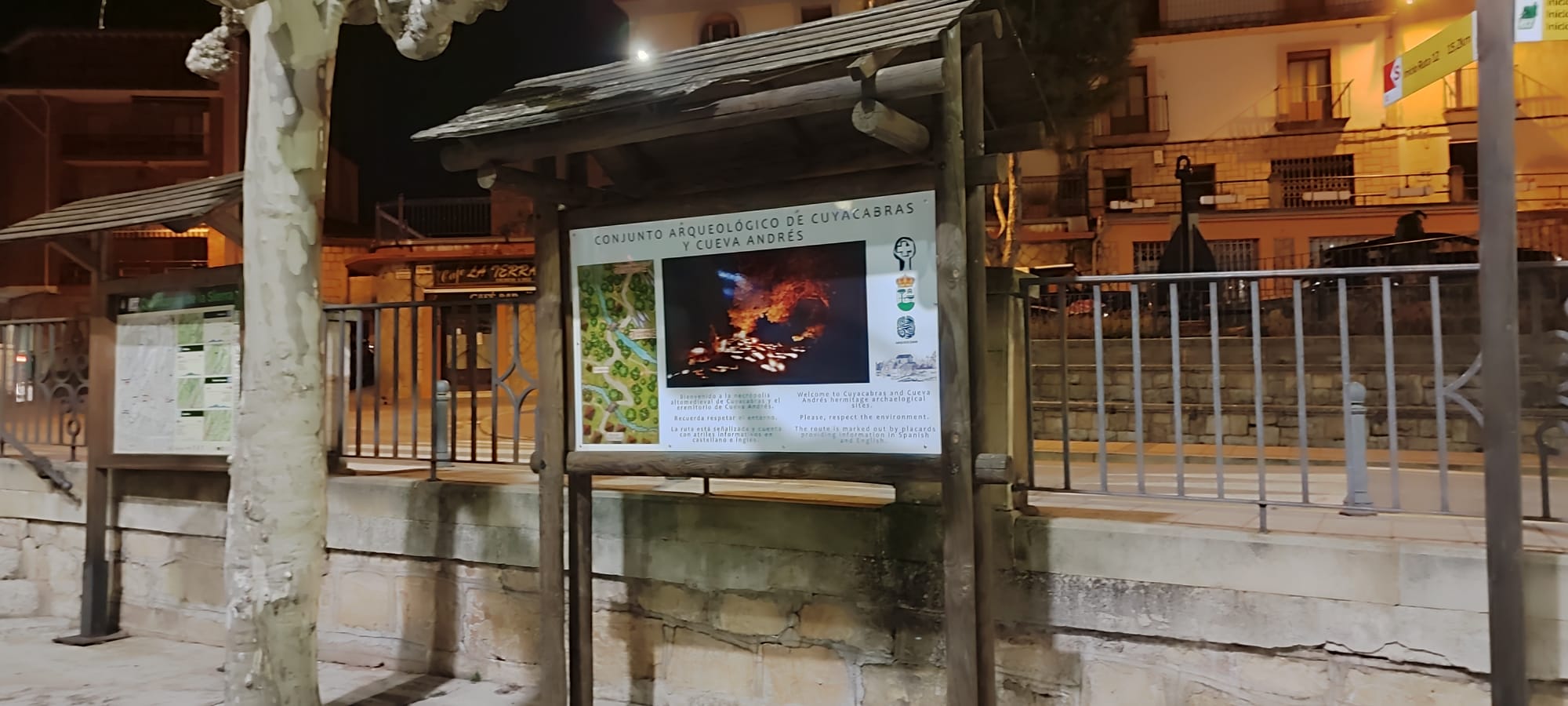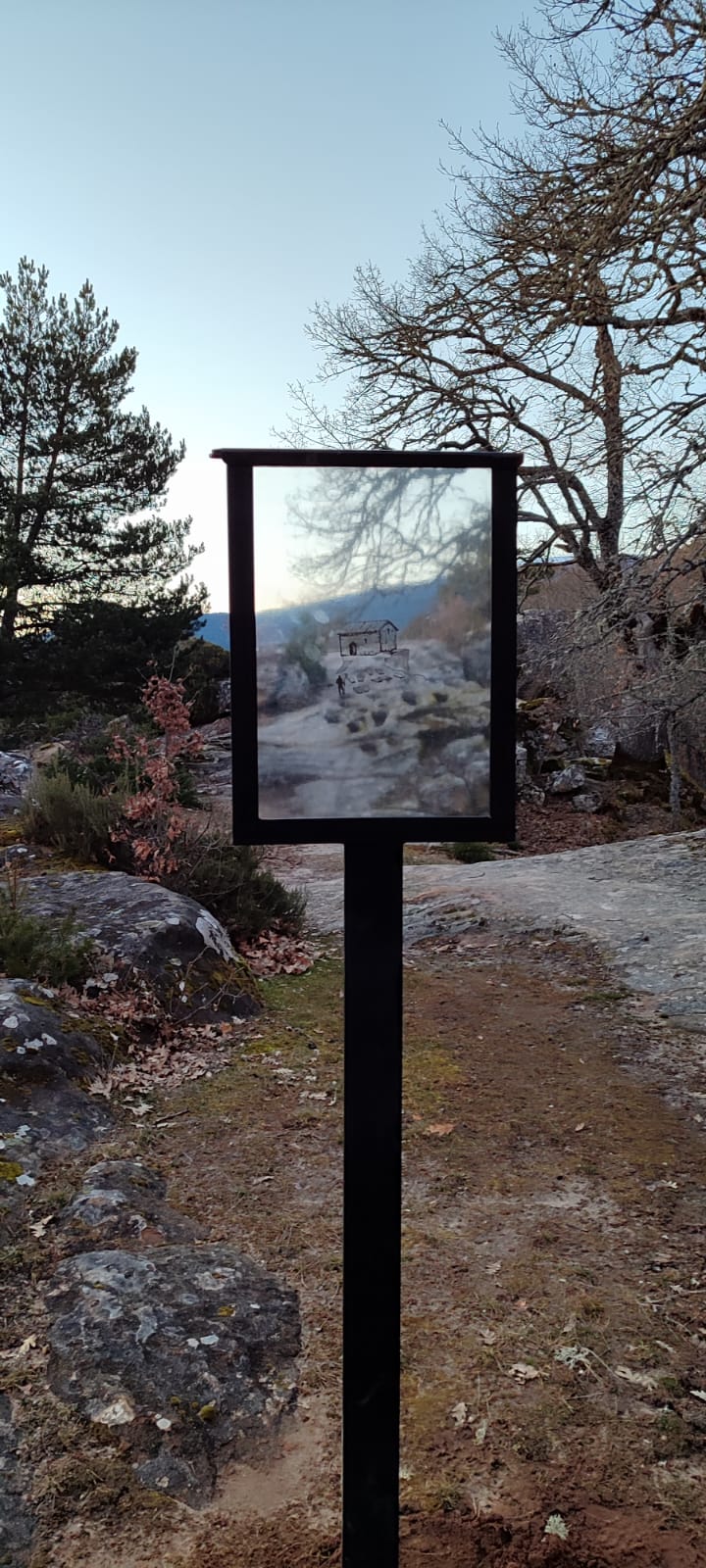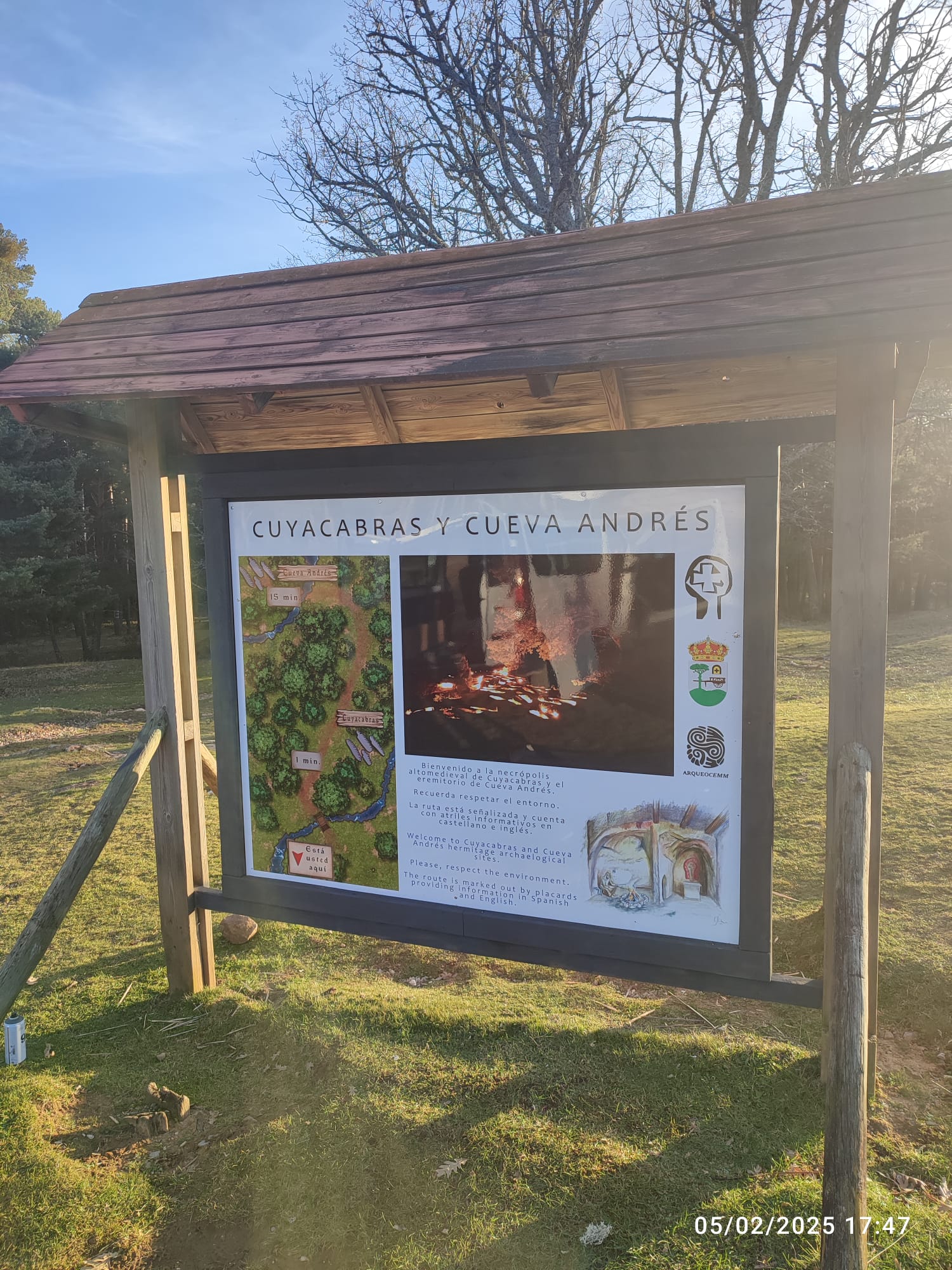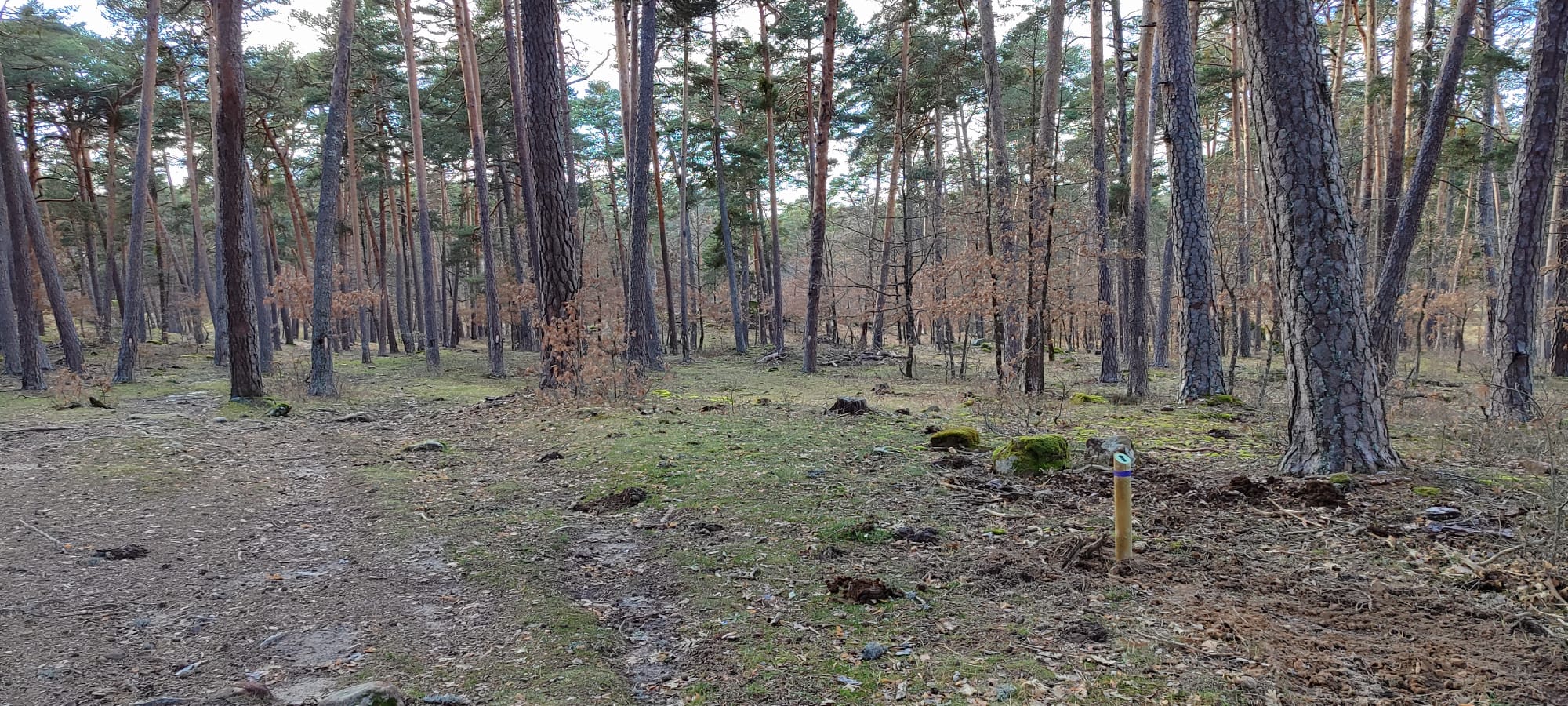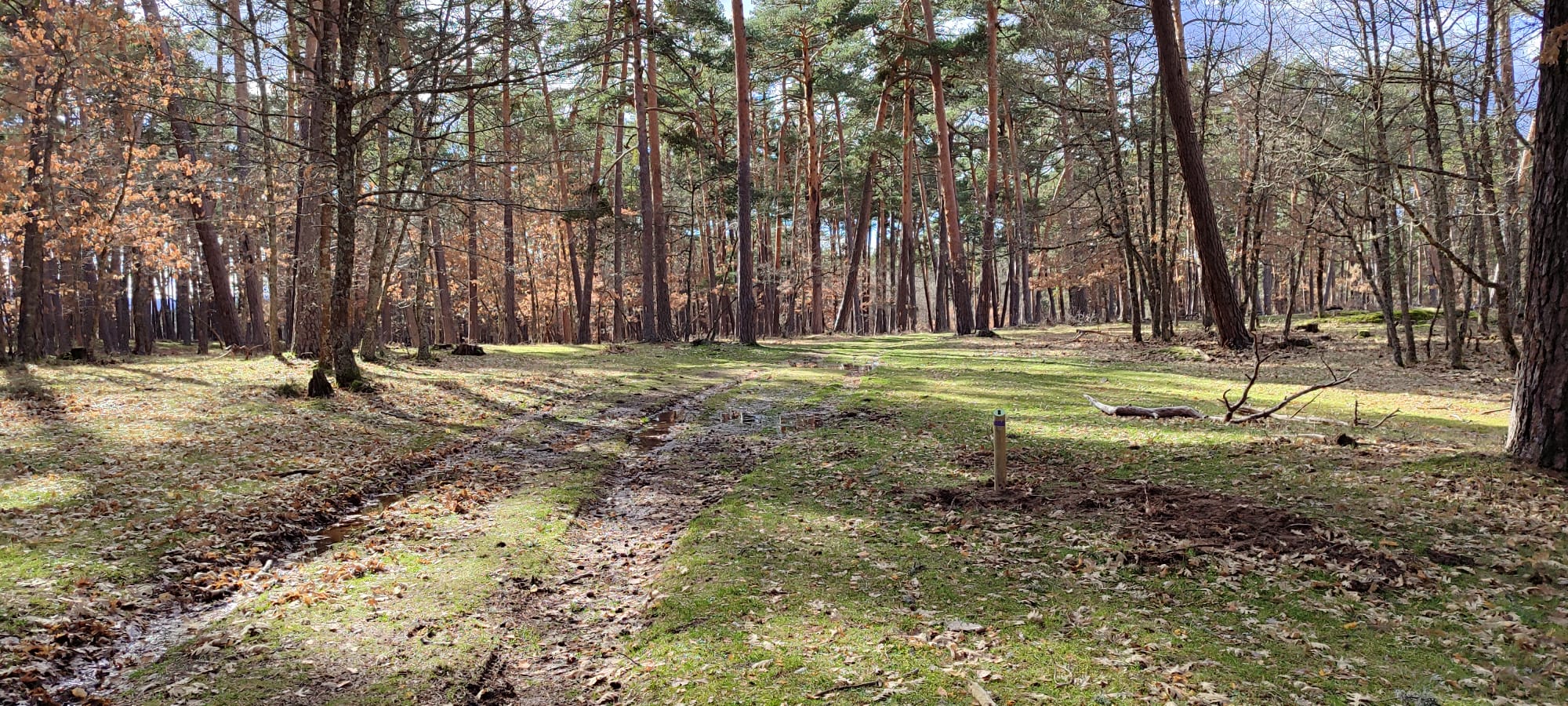Arlanza Sierra Viva & Comunal in Burgos
Enhancing hiking and cycling routes, preserving toponymy and restoring Cuyacabras' historical place
Recovery of the toponymy of the Arlanza mountain range and its promotion through hiking and cycling routes to attract tourism and achieve the triple bottom line: Profit (economic), People (social) and Planet (environmental).
Marking and revitalization of areas of natural landscape, historical, and cultural interest through indicating locations and routes for access via trails and traditional paths, such as the early medieval necropolis of Cuyacabras, declared a Site of Cultural Interest (BIC).
Marking and revitalization of areas of natural landscape, historical, and cultural interest through indicating locations and routes for access via trails and traditional paths, such as the early medieval necropolis of Cuyacabras, declared a Site of Cultural Interest (BIC).
Spain
Quintanar de la Sierra
Prototype level
Yes
Yes
Yes
No
No
09289: Quintanar de la Sierra (ES)
Enhance the historical and cultural heritage of the Pinares region and recover the toponymy of the Arlanza mountains. This advanced-stage project has already undertaken actions to strengthen the area's natural and cultural assets.
The general objective is to foster a deeper connection between the local community and its environment by preserving and promoting natural and historical heritage, integrating sustainability, accessibility, and citizen participation.
The target groups include local residents, tourists interested in natural and cultural heritage, neighborhood associations, and organizations dedicated to environmental and historical conservation. The project also focuses on making spaces accessible to people with reduced mobility.
In its first phase, nine nature trails have been developed, departing from the municipality and crossing the Arlanza mountains, linking key points such as the Chorlón waterfall, the Arlanza River's source in Sanza, the Neila Glacial Lagoons, the Cuyacabras Early Medieval Necropolis, and the Mozarabic Hermitage of Cueva Andrés.
Additionally, the necropolis, declared a Cultural Heritage Site, has been revitalized with modern signage and new interpretation techniques.
The next phases include:
-Engaging local communities and associations in designing new routes and stories.
-Recovering historical toponyms to reinforce communal identity.
-Improving accessibility with signage adapted for people with reduced mobility.
-Promoting immersive tourism experiences that connect visitors with local businesses.
-Encouraging a circular economy by integrating tourism, culture, and sustainable development.
Expected results include stronger social cohesion through active community participation, increased tourist appeal, enhanced local economic growth, and heightened awareness of heritage conservation. Ultimately, the goal is to establish Quintanar de la Sierra as a benchmark in sustainable and cultural tourism within the NEB framework.
The general objective is to foster a deeper connection between the local community and its environment by preserving and promoting natural and historical heritage, integrating sustainability, accessibility, and citizen participation.
The target groups include local residents, tourists interested in natural and cultural heritage, neighborhood associations, and organizations dedicated to environmental and historical conservation. The project also focuses on making spaces accessible to people with reduced mobility.
In its first phase, nine nature trails have been developed, departing from the municipality and crossing the Arlanza mountains, linking key points such as the Chorlón waterfall, the Arlanza River's source in Sanza, the Neila Glacial Lagoons, the Cuyacabras Early Medieval Necropolis, and the Mozarabic Hermitage of Cueva Andrés.
Additionally, the necropolis, declared a Cultural Heritage Site, has been revitalized with modern signage and new interpretation techniques.
The next phases include:
-Engaging local communities and associations in designing new routes and stories.
-Recovering historical toponyms to reinforce communal identity.
-Improving accessibility with signage adapted for people with reduced mobility.
-Promoting immersive tourism experiences that connect visitors with local businesses.
-Encouraging a circular economy by integrating tourism, culture, and sustainable development.
Expected results include stronger social cohesion through active community participation, increased tourist appeal, enhanced local economic growth, and heightened awareness of heritage conservation. Ultimately, the goal is to establish Quintanar de la Sierra as a benchmark in sustainable and cultural tourism within the NEB framework.
Heritage
Tourism
Sustainability
Community
Accessibility/Inclusion
Environmental sustainability is achieved by restoring and promoting the historical and natural landscapes of the Pinares region. The initiative prioritizes the protection of biodiversity, responsible tourism, and the conservation of historical landmarks such as the Cuyacabras Necropolis and the Mozarabic Hermitage of Cueva Andrés. The use of modern eco-friendly signage and interpretation techniques minimizes the ecological footprint while enhancing visitor experience.
Social sustainability is ensured through active community participation. Local residents and associations contribute by sharing personal histories, restoring traditional toponyms, and co-creating new routes that strengthen regional identity. Moreover, the initiative includes accessibility improvements to make cultural and natural sites available to people with reduced mobility, reinforcing inclusivity.
Economic sustainability is fostered by promoting circular economy principles. The initiative encourages synergies between tourism, local businesses, and cultural heritage. Immersive tourism experiences, such as guided tours and storytelling activities, support local business, hospitality services, and small enterprises, creating sustainable economic opportunities.
Future actions will continue reinforcing these sustainability goals by expanding community-driven projects, increasing accessibility adaptations, and integrating digital tools for heritage preservation. This initiative serves as a model for balancing cultural preservation with sustainable tourism, showcasing how local communities can play a central role in shaping a resilient and inclusive future in line with sustainability and New European Bauhaus values.
Social sustainability is ensured through active community participation. Local residents and associations contribute by sharing personal histories, restoring traditional toponyms, and co-creating new routes that strengthen regional identity. Moreover, the initiative includes accessibility improvements to make cultural and natural sites available to people with reduced mobility, reinforcing inclusivity.
Economic sustainability is fostered by promoting circular economy principles. The initiative encourages synergies between tourism, local businesses, and cultural heritage. Immersive tourism experiences, such as guided tours and storytelling activities, support local business, hospitality services, and small enterprises, creating sustainable economic opportunities.
Future actions will continue reinforcing these sustainability goals by expanding community-driven projects, increasing accessibility adaptations, and integrating digital tools for heritage preservation. This initiative serves as a model for balancing cultural preservation with sustainable tourism, showcasing how local communities can play a central role in shaping a resilient and inclusive future in line with sustainability and New European Bauhaus values.
The project creates a harmonious connection between design, nature, and historical identity, offering visitors an enriching and immersive journey.
Aesthetic excellence is achieved through thoughtful landscape integration. The restoration of historical sites respects traditional materials and forms while introducing modern interpretative elements. Signage and pathways blend natural and cultural heritage with the environment, preserving the scenic beauty of the Pinares region and reinforcing a sense of timelessness.
The emotional impact is central to the visitor experience. Through carefully designed routes, storytelling and participatory elements, the initiative fosters a deep emotional bond between people and place. The recovery of historical toponyms and local narratives strengthens cultural identity, making each journey not just a physical exploration but an emotional connection with the past and present (and hope, future...)
Cultural enrichment is a fundamental goal. Visitors engage with the history and traditions of the region through immersive experiences, interactive installations, and guided activities. The initiative actively involves local communities, ensuring that their voices, memories, and knowledge shape the visitor experience, making it authentic and deeply rooted in heritage.
Moving forward, the initiative will continue to refine and expand these experiential aspects by introducing new interactive formats, ITC, integrating digital storytelling, and strengthening partnerships with cultural organizations. This approach positions the project as an exemplary model of how aesthetics, emotional engagement, and cultural value can come together to enhance both visitor experience and community pride.
Aesthetic excellence is achieved through thoughtful landscape integration. The restoration of historical sites respects traditional materials and forms while introducing modern interpretative elements. Signage and pathways blend natural and cultural heritage with the environment, preserving the scenic beauty of the Pinares region and reinforcing a sense of timelessness.
The emotional impact is central to the visitor experience. Through carefully designed routes, storytelling and participatory elements, the initiative fosters a deep emotional bond between people and place. The recovery of historical toponyms and local narratives strengthens cultural identity, making each journey not just a physical exploration but an emotional connection with the past and present (and hope, future...)
Cultural enrichment is a fundamental goal. Visitors engage with the history and traditions of the region through immersive experiences, interactive installations, and guided activities. The initiative actively involves local communities, ensuring that their voices, memories, and knowledge shape the visitor experience, making it authentic and deeply rooted in heritage.
Moving forward, the initiative will continue to refine and expand these experiential aspects by introducing new interactive formats, ITC, integrating digital storytelling, and strengthening partnerships with cultural organizations. This approach positions the project as an exemplary model of how aesthetics, emotional engagement, and cultural value can come together to enhance both visitor experience and community pride.
Accessibility is a fundamental pillar of the initiative. Trails and historical sites are being adapted to accommodate people with reduced mobility, featuring improved pathways, tactile signage, and inclusive interpretation methods. By ensuring barrier-free access on most routes, the initiative enables diverse audiences to engage with the region’s cultural and natural heritage.
Affordability is addressed by offering open access to natural and cultural sites and promoting cost-effective experiences for visitors. Partnerships with local businesses facilitate affordable accommodations, services, and guided tours, ensuring that tourism remains inclusive and benefits the local economy without creating financial barriers.
Participatory governance plays a crucial role in shaping the initiative. Local communities, associations, City Hall and Provincial Council actively contribute to decision-making processes, ensuring that the project reflects the needs and aspirations of all. Workshops and collaborative forums allow residents to share their knowledge, shape new routes, and recover historical toponyms, reinforcing a collective sense of ownership.
New social models emerge by integrating local traditions with innovative engagement methods. The initiative promotes intergenerational exchange, enabling elderly residents to share oral histories with younger generations and visitors. It also fosters inclusive tourism, where visitors not only explore but also actively contribute to the community’s cultural preservation.
Future actions will enhance inclusive features by expanding participatory design approaches, further improving accessibility measures, and developing digital tools for remote engagement. This initiative serves as an exemplary model of how inclusive principles can be embedded in cultural and environmental projects, ensuring equitable access, shared governance, and long-term social cohesion.
Affordability is addressed by offering open access to natural and cultural sites and promoting cost-effective experiences for visitors. Partnerships with local businesses facilitate affordable accommodations, services, and guided tours, ensuring that tourism remains inclusive and benefits the local economy without creating financial barriers.
Participatory governance plays a crucial role in shaping the initiative. Local communities, associations, City Hall and Provincial Council actively contribute to decision-making processes, ensuring that the project reflects the needs and aspirations of all. Workshops and collaborative forums allow residents to share their knowledge, shape new routes, and recover historical toponyms, reinforcing a collective sense of ownership.
New social models emerge by integrating local traditions with innovative engagement methods. The initiative promotes intergenerational exchange, enabling elderly residents to share oral histories with younger generations and visitors. It also fosters inclusive tourism, where visitors not only explore but also actively contribute to the community’s cultural preservation.
Future actions will enhance inclusive features by expanding participatory design approaches, further improving accessibility measures, and developing digital tools for remote engagement. This initiative serves as an exemplary model of how inclusive principles can be embedded in cultural and environmental projects, ensuring equitable access, shared governance, and long-term social cohesion.
This initiative actively involves citizens and civil society, ensuring that heritage preservation and sustainable development benefit the entire community. By fostering participation, it strengthens social ties, enhances local identity, and promotes inclusive tourism.
From the outset, residents, historians, and local associations have played a key role in defining routes, restoring historical landmarks, and recovering traditional toponyms. The revitalization of the Cuyacabras Necropolis and the planned creation of a cultural dissemination center in the forest provide new opportunities for community-led heritage conservation. The reconstruction of "La Tenada de Cuyacabras" and the excavation of a medieval dwelling further engage citizens in preserving and rediscovering their history through hands-on collaboration.
Future engagement will focus on expanding accessibility, immersive experiences, and digital tools such as QR codes, 3D reconstructions, and mobile applications, making historical knowledge more inclusive and interactive. The involvement of diverse age groups fosters intergenerational exchange, where oral histories and traditional craftsmanship are shared and revitalized.
Beyond cultural preservation, the initiative positively impacts the local economy. By integrating tourism with small businesses and sustainable practices, it supports the circular economy and promotes long-term economic resilience. Inclusive governance ensures that all community members, including those with mobility challenges, actively shape the project’s evolution.
This initiative exemplifies the principles of the New European Bauhaus, demonstrating how collaborative heritage conservation can create a more inclusive, sustainable, and aesthetically enriching environment. By placing citizens at its core, it transforms historical preservation into a shared, living experience that connects past, present, and future.
From the outset, residents, historians, and local associations have played a key role in defining routes, restoring historical landmarks, and recovering traditional toponyms. The revitalization of the Cuyacabras Necropolis and the planned creation of a cultural dissemination center in the forest provide new opportunities for community-led heritage conservation. The reconstruction of "La Tenada de Cuyacabras" and the excavation of a medieval dwelling further engage citizens in preserving and rediscovering their history through hands-on collaboration.
Future engagement will focus on expanding accessibility, immersive experiences, and digital tools such as QR codes, 3D reconstructions, and mobile applications, making historical knowledge more inclusive and interactive. The involvement of diverse age groups fosters intergenerational exchange, where oral histories and traditional craftsmanship are shared and revitalized.
Beyond cultural preservation, the initiative positively impacts the local economy. By integrating tourism with small businesses and sustainable practices, it supports the circular economy and promotes long-term economic resilience. Inclusive governance ensures that all community members, including those with mobility challenges, actively shape the project’s evolution.
This initiative exemplifies the principles of the New European Bauhaus, demonstrating how collaborative heritage conservation can create a more inclusive, sustainable, and aesthetically enriching environment. By placing citizens at its core, it transforms historical preservation into a shared, living experience that connects past, present, and future.
The success of this initiative is built upon the collaboration of multiple stakeholders.
At the local level, the Municipality of Quintanar de la Sierra has played a key role in the development of natural routes, providing the foundation for further expansion. Additionally, community members have actively participated in the revitalization of the Cuyacabras Necropolis, contributing knowledge, personal histories and hands-on involvement.
On a regional scale, the provincial government has supported the initiative through expertise, helping to implement modern signage and interpretation techniques that enhance the visitor experience. Their involvement has also facilitated coordination between different municipalities, ensuring a cohesive approach to heritage preservation.
At the national level, state funding has provided essential financial support for the restoration of historical sites and the development of sustainable tourism initiatives. These funds have enabled structural improvements, accessibility enhancements and the integration of new technologies in cultural interpretation.
Looking ahead to the European level, institutions such as the New European Bauhaus and other EU funding programs are expected to play a crucial role in supporting future phases of the initiative. European contributions would allow for further accessibility improvements, the development of innovative visitor experiences using digital tools and the reinforcement of sustainability and inclusion principles.
This multi-level collaboration exemplifies how different stakeholders can work together to protect cultural heritage while fostering sustainable development. By leveraging resources and expertise from various sectors, the initiative ensures long-term impact and continued innovation, serving as a model for heritage conservation.
At the local level, the Municipality of Quintanar de la Sierra has played a key role in the development of natural routes, providing the foundation for further expansion. Additionally, community members have actively participated in the revitalization of the Cuyacabras Necropolis, contributing knowledge, personal histories and hands-on involvement.
On a regional scale, the provincial government has supported the initiative through expertise, helping to implement modern signage and interpretation techniques that enhance the visitor experience. Their involvement has also facilitated coordination between different municipalities, ensuring a cohesive approach to heritage preservation.
At the national level, state funding has provided essential financial support for the restoration of historical sites and the development of sustainable tourism initiatives. These funds have enabled structural improvements, accessibility enhancements and the integration of new technologies in cultural interpretation.
Looking ahead to the European level, institutions such as the New European Bauhaus and other EU funding programs are expected to play a crucial role in supporting future phases of the initiative. European contributions would allow for further accessibility improvements, the development of innovative visitor experiences using digital tools and the reinforcement of sustainability and inclusion principles.
This multi-level collaboration exemplifies how different stakeholders can work together to protect cultural heritage while fostering sustainable development. By leveraging resources and expertise from various sectors, the initiative ensures long-term impact and continued innovation, serving as a model for heritage conservation.
Heritage conservation has played a central role in the revitalization of the Cuyacabras Necropolis, where experts have worked alongside local historians and community members to recover and protect significant historical assets while integrating modern conservation techniques. Future plans include archaeological excavation of a medieval dwelling, further deepening historical understanding and community involvement.
Architecture and traditional construction have been key in the planned reconstruction of "La Tenada de Cuyacabras."
Technology and digital innovation are integral to enhancing accessibility and visitor engagement. The integration of QR codes, 3D reconstructions and mobile app for routes allows for interactive storytelling and a deeper understanding of historical sites, making them more inclusive and engaging for diverse audiences.
Environmental sciences and sustainable tourism guide the ecological management of the routes and cultural sites. The initiative minimizes its environmental footprint while promoting responsible tourism and conservation practices.
Community and social engagement contribute to the participatory governance model, ensuring that local voices shape the project. This collaborative approach fosters a sense of ownership and intergenerational knowledge exchange, reinforcing the long-term sustainability of the initiative.
The interaction between these disciplines has been crucial in creating a well-rounded and innovative project.
Conservationists collaborate to ensure historical accuracy and feasibility while digital experts work with heritage to develop immersive experiences. Environmental and tourism specialists align conservation efforts with economic opportunities, ensuring a balanced and sustainable approach. This interdisciplinary collaboration adds significant value by merging tradition with innovation, enhancing accessibility and ensuring long-term cultural and environmental sustainability.
Architecture and traditional construction have been key in the planned reconstruction of "La Tenada de Cuyacabras."
Technology and digital innovation are integral to enhancing accessibility and visitor engagement. The integration of QR codes, 3D reconstructions and mobile app for routes allows for interactive storytelling and a deeper understanding of historical sites, making them more inclusive and engaging for diverse audiences.
Environmental sciences and sustainable tourism guide the ecological management of the routes and cultural sites. The initiative minimizes its environmental footprint while promoting responsible tourism and conservation practices.
Community and social engagement contribute to the participatory governance model, ensuring that local voices shape the project. This collaborative approach fosters a sense of ownership and intergenerational knowledge exchange, reinforcing the long-term sustainability of the initiative.
The interaction between these disciplines has been crucial in creating a well-rounded and innovative project.
Conservationists collaborate to ensure historical accuracy and feasibility while digital experts work with heritage to develop immersive experiences. Environmental and tourism specialists align conservation efforts with economic opportunities, ensuring a balanced and sustainable approach. This interdisciplinary collaboration adds significant value by merging tradition with innovation, enhancing accessibility and ensuring long-term cultural and environmental sustainability.
This initiative stands out for its innovative approach compared to conventional heritage and tourism projects.
Unlike traditional conservation efforts that focus solely on physical restoration, this project integrates modern technologies such as QR codes, 3D reconstructions, and collaboration with a mobile app to create immersive and interactive experiences. This digital approach not only enhances accessibility but also fosters a deeper connection between visitors and heritage sites.
A key innovation is the participatory governance model, which actively involves local residents, historians, and businesses in shaping the initiative. Rather than imposing a top-down preservation strategy, the project encourages the community to contribute personal histories, knowledge and resources, ensuring that cultural memory remains.
In contrast to standard tourism projects that often prioritize mass appeal, this initiative promotes sustainable and responsible tourism. By linking cultural heritage to the local economy through circular economy principles, it benefits small businesses while minimizing environmental impact. The planned reconstruction of "La Tenada de Cuyacabras" and future archaeological excavations will be carried out using traditional techniques, not only preserving historical authenticity but also reviving lost construction methods in a scientifically documented process.
Another aspect is the integration of inclusive design principles. While many heritage sites remain inaccessible to people with mobility challenges, this project prioritizes accessibility improvements.
By merging digital innovation, participatory conservation, sustainable tourism and inclusive accessibility, this initiative sets a new benchmark for heritage projects. It demonstrates how the fusion of technology, tradition, and community involvement can transform heritage preservation into a dynamic and forward-thinking model for cultural sustainability.
Unlike traditional conservation efforts that focus solely on physical restoration, this project integrates modern technologies such as QR codes, 3D reconstructions, and collaboration with a mobile app to create immersive and interactive experiences. This digital approach not only enhances accessibility but also fosters a deeper connection between visitors and heritage sites.
A key innovation is the participatory governance model, which actively involves local residents, historians, and businesses in shaping the initiative. Rather than imposing a top-down preservation strategy, the project encourages the community to contribute personal histories, knowledge and resources, ensuring that cultural memory remains.
In contrast to standard tourism projects that often prioritize mass appeal, this initiative promotes sustainable and responsible tourism. By linking cultural heritage to the local economy through circular economy principles, it benefits small businesses while minimizing environmental impact. The planned reconstruction of "La Tenada de Cuyacabras" and future archaeological excavations will be carried out using traditional techniques, not only preserving historical authenticity but also reviving lost construction methods in a scientifically documented process.
Another aspect is the integration of inclusive design principles. While many heritage sites remain inaccessible to people with mobility challenges, this project prioritizes accessibility improvements.
By merging digital innovation, participatory conservation, sustainable tourism and inclusive accessibility, this initiative sets a new benchmark for heritage projects. It demonstrates how the fusion of technology, tradition, and community involvement can transform heritage preservation into a dynamic and forward-thinking model for cultural sustainability.
The initiative builds upon prior efforts by the municipality, which has already developed 9 natural routes and rehabilitated the Cuyacabras site with modern signage. These initial actions have laid a strong foundation for further cultural and environmental revitalization.
The next phase focuses on recovering and enhancing the toponymy of the Arlanza mountains and improving the routes, as well as implementing new initiatives in Cuyacabras. This process is divided into four key phases:
The first phase, research and planning, involves historical and linguistic analysis to document and restore traditional place names. This step is carried out with experts to ensure authenticity and relevance.
The second phase, citizen participation, is essential to the initiative. Unlike top-down projects, this approach actively involves local residents in storytelling, decision-making, and place-naming. Public forums, workshops, and interviews ensure that the project aligns with community knowledge and values.
The third phase, execution, includes improving the existing routes with enhanced signage, local stories, accessibility adaptations and digital tools such as QR codes or mobile app to create interactive visitor experiences. In Cuyacabras, planned actions include the reconstruction of "La Tenada de Cuyacabras" using traditional techniques and experimental archaeology, which will document and revive historical construction methods.
The final phase, monitoring and follow-up, ensures long-term sustainability. Evaluations, visitor feedback, and adaptive management strategies will help refine the initiative over time, ensuring that it continues to meet community needs while preserving cultural and environmental heritage.
By combining past achievements with new innovations in research, community involvement, and technology, this initiative establishes a replicable model for sustainable cultural and natural heritage preservation.
The next phase focuses on recovering and enhancing the toponymy of the Arlanza mountains and improving the routes, as well as implementing new initiatives in Cuyacabras. This process is divided into four key phases:
The first phase, research and planning, involves historical and linguistic analysis to document and restore traditional place names. This step is carried out with experts to ensure authenticity and relevance.
The second phase, citizen participation, is essential to the initiative. Unlike top-down projects, this approach actively involves local residents in storytelling, decision-making, and place-naming. Public forums, workshops, and interviews ensure that the project aligns with community knowledge and values.
The third phase, execution, includes improving the existing routes with enhanced signage, local stories, accessibility adaptations and digital tools such as QR codes or mobile app to create interactive visitor experiences. In Cuyacabras, planned actions include the reconstruction of "La Tenada de Cuyacabras" using traditional techniques and experimental archaeology, which will document and revive historical construction methods.
The final phase, monitoring and follow-up, ensures long-term sustainability. Evaluations, visitor feedback, and adaptive management strategies will help refine the initiative over time, ensuring that it continues to meet community needs while preserving cultural and environmental heritage.
By combining past achievements with new innovations in research, community involvement, and technology, this initiative establishes a replicable model for sustainable cultural and natural heritage preservation.
Several key elements make this project suitable for replication in other regions and communities.
The methodology, which integrates historical research, community participation, and sustainable tourism, can be applied to other heritage and natural territories. The structured four-phase approach—research and planning, citizen involvement, execution, and monitoring—ensures that similar projects can follow a clear roadmap to success.
The use of digital tools, such as QR, 3D reconstructions or app routes can be transferred to different locations, enhancing visitor engagement and accessibility. These technologies help preserve and communicate cultural heritage dynamically, making it more interactive and inclusive.
Community-driven storytelling and participatory governance are highly adaptable aspects of the initiative. The involvement of local populations in identifying, preserving, and promoting their heritage fosters social cohesion and ensures the long-term sustainability of similar projects. This approach empowers communities to take ownership of their cultural landscapes, reinforcing their identity and connection with their roots.
The experimental archaeology techniques applied in the reconstruction of historical structures provide a model that can be used to revive lost building methods in other contexts. This hands-on approach benefits researchers, craftspeople and the broader public by creating unique learning experiences and advancing heritage conservation methodologies.
By integrating heritage tourism with economic opportunities, this model supports local economies while ensuring cultural preservation.
Through its holistic approach, this initiative serves as a scalable example of how to blend tradition, innovation, and community engagement to revitalize and sustain cultural and natural heritage in diverse settings.
The methodology, which integrates historical research, community participation, and sustainable tourism, can be applied to other heritage and natural territories. The structured four-phase approach—research and planning, citizen involvement, execution, and monitoring—ensures that similar projects can follow a clear roadmap to success.
The use of digital tools, such as QR, 3D reconstructions or app routes can be transferred to different locations, enhancing visitor engagement and accessibility. These technologies help preserve and communicate cultural heritage dynamically, making it more interactive and inclusive.
Community-driven storytelling and participatory governance are highly adaptable aspects of the initiative. The involvement of local populations in identifying, preserving, and promoting their heritage fosters social cohesion and ensures the long-term sustainability of similar projects. This approach empowers communities to take ownership of their cultural landscapes, reinforcing their identity and connection with their roots.
The experimental archaeology techniques applied in the reconstruction of historical structures provide a model that can be used to revive lost building methods in other contexts. This hands-on approach benefits researchers, craftspeople and the broader public by creating unique learning experiences and advancing heritage conservation methodologies.
By integrating heritage tourism with economic opportunities, this model supports local economies while ensuring cultural preservation.
Through its holistic approach, this initiative serves as a scalable example of how to blend tradition, innovation, and community engagement to revitalize and sustain cultural and natural heritage in diverse settings.
This initiative addresses key global challenges by providing innovative local solutions rooted in sustainability, cultural preservation and community engagement.
One major challenge is the loss of cultural heritage due depopulation and environmental degradation. By restoring historical sites, reviving toponymy, and employing experimental archaeology, the initiative helps safeguard intangible and tangible heritage, ensuring that knowledge and traditions are passed on to future generations.
Another challenge is rural depopulation and economic decline. Many rural areas struggle to retain populations due to limited job opportunities and infrastructure. This initiative fosters economic regeneration by integrating heritage tourism with local businesses, creating new employment opportunities and promoting tourism as an alternative economic driver.
Environmental sustainability is a pressing global issue, and this project contributes to ecological conservation through responsible tourism and the promotion of traditional building techniques using natural primary materials. The initiative demonstrates how historical knowledge can inform modern sustainable practices, reducing environmental impact while maintaining cultural authenticity.
Social inclusion and accessibility remain critical concerns worldwide. This initiative actively involves local residents in decision-making ensuring that cultural assets benefit all. Additionally, accessibility improvements in routes and digital tools help make heritage sites more inclusive.
Lastly, technological adaptation is essential in preserving and communicating cultural heritage. The use of digital tools like QR codes, 3D and app ensures that heritage remains relevant and engaging in the modern world, while also serving as an educational resource.
This initiative provides a scalable and adaptable model that can be implemented in other regions, fostering sustainable and inclusive heritage preservation worldwide.
One major challenge is the loss of cultural heritage due depopulation and environmental degradation. By restoring historical sites, reviving toponymy, and employing experimental archaeology, the initiative helps safeguard intangible and tangible heritage, ensuring that knowledge and traditions are passed on to future generations.
Another challenge is rural depopulation and economic decline. Many rural areas struggle to retain populations due to limited job opportunities and infrastructure. This initiative fosters economic regeneration by integrating heritage tourism with local businesses, creating new employment opportunities and promoting tourism as an alternative economic driver.
Environmental sustainability is a pressing global issue, and this project contributes to ecological conservation through responsible tourism and the promotion of traditional building techniques using natural primary materials. The initiative demonstrates how historical knowledge can inform modern sustainable practices, reducing environmental impact while maintaining cultural authenticity.
Social inclusion and accessibility remain critical concerns worldwide. This initiative actively involves local residents in decision-making ensuring that cultural assets benefit all. Additionally, accessibility improvements in routes and digital tools help make heritage sites more inclusive.
Lastly, technological adaptation is essential in preserving and communicating cultural heritage. The use of digital tools like QR codes, 3D and app ensures that heritage remains relevant and engaging in the modern world, while also serving as an educational resource.
This initiative provides a scalable and adaptable model that can be implemented in other regions, fostering sustainable and inclusive heritage preservation worldwide.
The commitment to implementing this initiative is demonstrated through a structured series of activities that align with the values of the New European Bauhaus: sustainability, inclusivity, and aesthetics.
In the initial phase, extensive research was conducted to document historical and cultural heritage, ensuring an evidence-based foundation. This was followed by the creation of 9 natural routes and the rehabilitation of Cuyacabras with modern signage, incorporating digital tools for visitor engagement.
The next steps focus on the recovery of the toponymy of the Arlanza mountains and the enhancement of cultural and historical routes. This phase consists of four key stages:
Research and Planning – Experts and locals analyze historical documents and oral traditions to reconstruct place names and validate their significance.
Citizen Participation – Community members actively contribute through storytelling workshops, participatory mapping and co-design sessions, ensuring local engagement.
Implementation – Improved signage, accessibility features, and digital tools (QR, augmented reality) will be installed. In Cuyacabras, the reconstruction of "La Tenada de Cuyacabras" and experimental archaeology initiatives will showcase traditional craftsmanship and sustainable construction techniques.
Monitoring and Evaluation – Continuous assessment ensures adaptability and long-term impact, incorporating feedback from visitors and stakeholders.
The principles of the New European Bauhaus are embedded throughout the process: aesthetics are reflected in the design of signage and reconstructed heritage elements, inclusivity is ensured through accessibility adaptations and community-driven decision-making, and sustainability is prioritized through eco-friendly materials and circular economy integration.
In the initial phase, extensive research was conducted to document historical and cultural heritage, ensuring an evidence-based foundation. This was followed by the creation of 9 natural routes and the rehabilitation of Cuyacabras with modern signage, incorporating digital tools for visitor engagement.
The next steps focus on the recovery of the toponymy of the Arlanza mountains and the enhancement of cultural and historical routes. This phase consists of four key stages:
Research and Planning – Experts and locals analyze historical documents and oral traditions to reconstruct place names and validate their significance.
Citizen Participation – Community members actively contribute through storytelling workshops, participatory mapping and co-design sessions, ensuring local engagement.
Implementation – Improved signage, accessibility features, and digital tools (QR, augmented reality) will be installed. In Cuyacabras, the reconstruction of "La Tenada de Cuyacabras" and experimental archaeology initiatives will showcase traditional craftsmanship and sustainable construction techniques.
Monitoring and Evaluation – Continuous assessment ensures adaptability and long-term impact, incorporating feedback from visitors and stakeholders.
The principles of the New European Bauhaus are embedded throughout the process: aesthetics are reflected in the design of signage and reconstructed heritage elements, inclusivity is ensured through accessibility adaptations and community-driven decision-making, and sustainability is prioritized through eco-friendly materials and circular economy integration.

